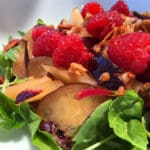Plum Facts:

Nutrition Facts
Serving Size 1 Fruit
Servings Per Container 1
Amount Per Serving
Calories 30
Calories from Fat 0
% Daily Value*
Total Fat 0g
0%
Saturated Fat 0g
0%
Trans Fat 0g
Cholesterol 0mg
0%
Sodium 0mg
0%
Total Carbohydrate 8g
3%
Dietary Fiber 1g
4%
Sugars 7g
Protein 0g
Vitamin A
5%
Vitamin C
10%
Calcium
0%
Iron
1%
Vitamin E
1%
Vitamin K
5%
Thiamin
1%
Riboflavin
1%
Niacin
1%
Vitamin B6
1%
Folate
1%
Pantothenic Acid
1%
Magnesium
1%
Phosphorus
1%
Potassium
3%
Copper
2%
Manganese
2%
*Percent Daily Values are based on a 2,000 calorie diet. Your daily values may be higher or lower depending on your calorie needs.
PQ (Protein Quality) x PDCAAS (Protein Digestibility Corrected Amino Acid Score) - 30
Additional Contents
- lutein
- peonidins
- zeaxanthin
- phytosterols
- pelargonidin
- anthocyanins
- beta-carotene
- chlorogenic acid
- beta-cryptoxanthin
- neochlorogenic acid
- hydroxycinnamic acids
- complex carbohydrates
Potential Health Benefits
- powerful disease protection
- powerful anti-cancer properties
- improve memory function
- decrease oxidative stress
- eyesight health boost
- energy boost
Potential Athletic Benefits
- Increase bone health and protection.
- Increase digestive health for better nutrient absorption, translating to a healthier body and better performance.
- Slow absorption of complex carbohydrates for sustained energy release.
Glycemic Index Rank
24 out of 100
| Rank | Value |
|---|---|
| Low Glycemic | less than 55 |
Food Sensitivity Rank
0.6 to 1 ratio
| Rank | Value |
|---|---|
| Low for Fructose Sensitivity | less than 1 (fructose to glucose ratio) |
Plums rank high on nutrient density as well as anti-cancer properties from their dense content of phytochemicals and antioxidants. Plums make for a great power snack for strenuous days and stressful events. Interestingly, new research suggests that they may also help to protect our eyes and our bones from stress and degeneration.
- The Effect of Dried Plum on Osteoporosis
- The Effect of Prunes on Gastrointestinal Function
- Dried Plums (Prunes) vs. Psyllium for Constipation
- Identification, Quantitative Determination, and Antioxidant Activities of Cholorogenic Acid Isomers in Prune
- Neochlorogenic Acid Inhibits Lipopolysaccharide-Induced Activation and Pro-Inflammatory Responses in BV2 Microglial Cells

neochlorogenic acid
is classified as a naturally occuring polyphenolic compound found in prunes. Neochlorogenic acid is responsible for powerful free radical scavenging properties, decreasing the risk of cancer, and may also carry natural laxative properties for improved digestion.
Sources include: USDA
***All-Body Fitness takes no responsibility for the accuracy of the information provided above. Please contact a medical doctor or a registered dietitian for nutrition advice.




